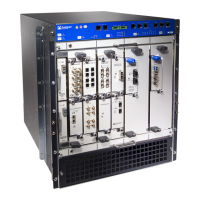•
OK and FAIL LEDs for the front and rear fan trays.
•
OK and FAIL LEDs for each power supply.
M120 Alarm Relay Contacts on the Craft Interface
The host interface has two alarm relay contacts for connecting the router to external
alarm devices (see Figure 6 on page 11). Whenever a system condition triggers either
the red or yellow alarm on the craft interface, the alarm relay contacts are also activated.
The alarm relay contacts are located below the Routing Engine ports.
M120 External Clock Interface Ports on the Craft Interface
Two external clock ports EXT CLOCK to the right of the craft interface alarm LEDs enable
you to connect the router’s internal Stratum 3 clock to an external reference clock source
with an RJ-45 cable. Using the router’s software, you can configure the internal Stratum
3 clock to synchronize with an external Building Integrated Timing System (BITS) or SDH
Equipment Timing Source (SETS) timing source by including a clock synchronization
statement at the [edit chassis] hierarchy level.
NOTE: Refer to the, Junos OS Administration Library for configuration
information.
The EXT CLOCK ports are labeled A and B. They accept two RJ-45 connectors for external
clock inputs with T1 or E1 reference clocks.
M120 Routing Engine Interface Ports and Status Indicators
To the right of the alarm relay contact on the craft interface are two sets of ports that
connect the Routing Engines to one or more external devices on which system
administrators can issue Junos OS command-line interface (CLI) commands to manage
the router (see Figure 6 on page 11). The set of ports in the left connects to the Routing
Engine in the left Routing Engine slot (REO) and the set on the right connects to the
Routing Engine (RE1) in the right Routing Engine slot.
The ports with the indicated label in each set function as follows:
•
AUX—Connects the Routing Engine to a laptop, modem, or other auxiliary device
through a cable with an RJ-45 connector.
•
CONSOLE—Connects the Routing Engine to a system console through a cable with an
RJ-45 connector.
•
ETHERNET—Connects the Routing Engine through an Ethernet connection to a
management LAN (or any other device that plugs into an Ethernet connection) for
out-of-band management. The port uses an autosensing RJ-45 connector to support
both 10- and 100-Mbps connections. Two small LEDs on the bottom of the port indicate
the connection in use: the LED lights yellow or green for a 10-Mbps or 100-Mbps
connection, and the LED lights green when traffic is passing through the port.
Copyright © 2018, Juniper Networks, Inc.12
M120 Multiservice Edge Router Hardware Guide

